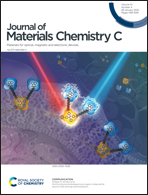Revealing the microstructure-related light-induced degradation for all-polymer solar cells based on regioisomerized end-capping group acceptors†
Abstract
With the state-of-the-art impressive power conversion efficiency (PCE) of all-polymer solar cells (all-PSCs) surpassing 17%, it has become increasingly urgent to achieve highly stable devices under long-term operational conditions. Herein, the photostability of all-PSCs based on three isomeric polymer acceptors (PAs, PYTT-x (x = 1–3)), as well as their underlying degradation mechanisms, were investigated. Impressively, the relatively amorphous PA PYTT-1 and crystalline PA PYTT-3 provided completely different degradation mechanisms and morphological evolutionary processes, deriving from domain shrinkage-related increased energetic bulk traps in the former, and increased surface-assisted recombination together with domain growth and vertical phase rearrangement in the latter. In contrast, the decent longevity of PYTT-2 with moderate crystallinity almost preserves the initial nanostructure with a slight loss of molecular ordering. The analysis further revealed that three types of degradation behaviors along with related blend microstructure evolution are correlated with the synergistic effects of intermolecular interactions and crystallization characteristics. Not only do these findings underscore the key role of photovoltaic material design regarding the regioisomerized end-capping groups in the determination of film formation and its blend microstructure evolution under light-soaking for long exposure times, but more importantly, also denote the correlation between the molecular structure and device photostability directly.



 Please wait while we load your content...
Please wait while we load your content...